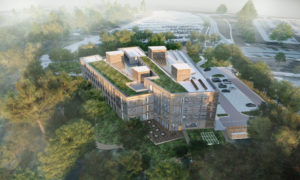ZAS unveils wood-based, net-zero carbon design for new TRCA HQ

Rendering courtesy ZAS Architects
Inspired by the Toronto and Region Conservation Authority’s (TRCA’s) role in managing and protecting the city’s natural water and ravine systems, ZAS Architects in a joint venture with Bucholz McEvoy Architects designed the organization’s new headquarters into one of the most energy efficient mid-rise commercial buildings in North America.
In addition to providing TRCA with a new light-filled and flexible workplace, unique to the organization’s vision was the holistic and ‘wood first’ approach. From the elevator core to the exterior cladding, the building uses a mass timber structure and will be built almost entirely out of wood.
Amplifying the conservation work of TRCA at multiple touch points, the exposed mass timber structure, wood staircase, and elevator core, provides a biophilic work environment. Sitting adjacent to the Black Creek ravine system (Toront), the building’s geometry follows the natural topography creating terraces that move with the ravine edge. At each level, views from the south-facing façade pull the ravine edge visually into the core of the project, providing opportunities for employees and visitors to engage with the natural landscape.
Cedar wood cladding on the exterior is sourced from Ontario and references the heritage buildings in the adjacent Black Creek Pioneer Village, some dating back 150 years.
In addition to the use of wood and an energy efficient building envelope, other sustainable design features include a green roof, rainwater harvesting, low impact landscape development, and solar chimneys which will generate five per cent of the building’s electricity. Using a combination of low carbon electrical power from Ontario’s grid, geothermal energy, and roof-mounted solar panels, the project is targeting Net Carbon Zero, Leadership in Energy and Environmental Design (LEED) Platinum V4, Toronto Green Standard Level 2, and WELL Silver certification. When compared to traditional office buildings of this size, carbon emissions along with operating costs are projected to be reduced by up to 50 per cent.
TRCA’s new predominantly plant-based workplace seek to become a living model for TRCA to show their partners and visitors how projects can be built sensitively and responsibly next to ravine landscapes, ZAS Architects said in a press release. In addition to providing visitors with views of the Black Creek ravine from public meeting rooms, a major focal point for the employee and visitor experience are four water walls in the main atrium. Encased in glass and extending to the height of the building, the water walls serve a dual function, symbolizing TRCA’s role of safeguarding the Greater Toronto Area’s (GTA’s) watersheds while also being an integral part of the building’s HVAC system. Making a part of the building’s mechanical system visible was an unusual but very intentional choice.
“Through the water wall feature, we are making the building’s life support systems that are usually hidden infrastructure visible and tangible. Making the invisible, visible when it comes to energy use, serves as a very real reminder of the impact our daily lives and decisions have on the planet every day,” said Duckworth Pilkington, principal, ZAS Architects.
Building on this theme, the design combines cutting-edge sustainability technologies with traditional techniques. While a high-tech HVAC system and an automated exterior blind system manages the building’s heating and cooling, occupants will be engaged to become active participants. Under the right exterior conditions staff will be alerted by the building’s automation system through their personal devices, to either open or close windows to ensure the building is using energy efficiently.
TRCA broke ground on their new administrative office in January last year. The mass timber structure will be in place by the end of September this year with occupancy in September 2022.


